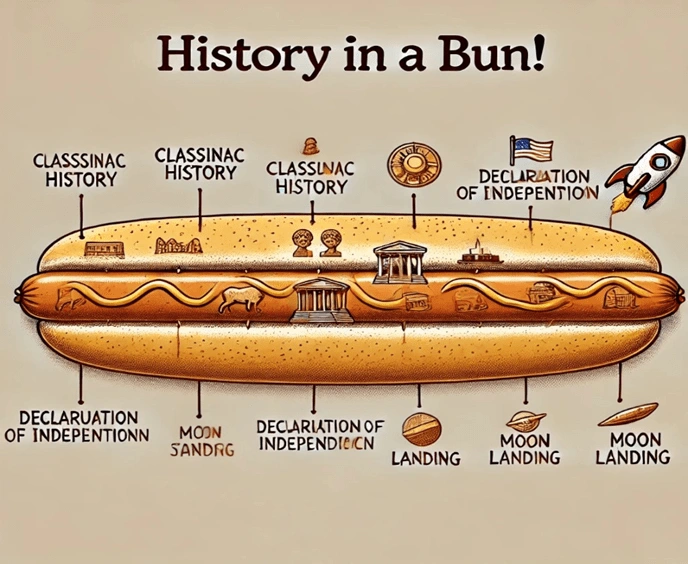YouTube Script
Here are 3 scripts.
The first one is the first two pages and the outline of a 20-page script, designed for a one-hour video/documentary.
The second and the third are two versions of the same script. It was a test project for a YouTube channel. The whole script is supposed to be longer.
1.Hot Dog Culture: 500 years of history, from immigrant food to American pop icon
Thumbnail idea

Well... maybe DALL-E hasn't studied much history and is a bit forgetful because it repeated some of the events. And actually it's not great at grammar either. It’s also a bit obsessed with the Moon, I guess. I'm sure a human being could create this hot dog historical timeline better :)
Logline or summary
Did you know that President Franklin D. Roosevelt served hot dogs to King George VI (he ate two) and Queen Elizabeth II? If not, welcome to the history of this famous street food dish. From the Paleolithic era to XIV Germany, to the Great Depression, we will explore this phenomenon not just as a culinary one, but as a cultural value and social movement.
Script Outline
1. Introduction
2. European Roots to American Soil
Medieval sausage-making traditions
German immigration waves
First appearances in American cities
3. The Birth of an Icon
Charles Feltman and Coney Island
Etymology of "hot dog"
1893 Chicago World's Fair
Rise of Nathan's Famous
4. Hot Dogs in American Life
Baseball and hot dog love affair
Great Depression era resilience
FDR's "Hot Dog Summit" with King George VI
Post-war boom: Backyard BBQs and drive-ins
5. Coast to Coast: Regional Variations (10 minutes)
Chicago's "dragged through the garden" dog
New York vs. New Jersey styles
Unique regional interpretations
6. The Modern Hot Dog
Gourmet revolution
Health trends and adaptations
Competitive eating phenomenon
Multicultural influences
7. Hot Dogs in Pop Culture
Iconic movie scenes and music references
Wienermobile history
Hot dogs in advertising and branding
8. Conclusion: The Enduring Appeal
Reflection on hot dogs as a symbol of American culture
The future of the hot dog
First 2 pages of script
A hot dog is not a sandwich. A hot dog is a hot dog.
This is the first and incontrovertible statement of the National Hot Dog and Sausage Council, the most important international association dedicated to this food.
The crackling sound of meat on the metal grill, the intense smoky aroma of spices, and the anticipation of “dressing the dog” with juicy sauces and crispy, gooey toppings…
…For millions of people around the world, but especially Americans, these intense sensations evoke memories of childhood and community, like sports games, family barbecues, fairs, and balls.
The hot dog, or heisser hund, or perrito caliente, depending on which part of the world you order it in, has numerous regional varieties in preparation, taste, and toppings, but for Americans, it has become not just a traditional food, but a status symbol. Various regions in the U.S. have their own unique styles of hot dogs, from Chicago’s loaded dog to the chili-topped Coney dog. The diversity of hot dog styles reflects the immigrant cultures that shaped them, showcasing America’s multicultural food heritage.
It’s estimated that during peak hot dog season, from Memorial Day to Labor Day, Americans typically consume 7 billion hot dogs. That’s 818 hot dogs devoured every second during that period of summer filled with outdoor activities like barbecues, picnics, and sports events.
Moreover, on Independence Day, Americans are expected to enjoy 150 million hot dogs. This quantity is enough to stretch from Washington to Los Angeles more than five times, for about 21,500 kilometers.
But perhaps many don’t know that, indeed, the history of the hot dog doesn’t begin in America, but rather in Europe, more precisely in Germany, more than 500 years ago. And not only that: even the ancient Greeks and Romans, in 900 B.C., already spoke about sausages in their literary works.
So how is it possible that a humble European food crossed the Atlantic and became so popular in America, becoming one of the nation’s culinary symbols – so much so that it was the first food eaten by astronauts on the Moon?
This is the history of hot dog.
It is said that the first name of this food was “frankfurter,” and it was indeed a sausage without the soft bread that contained it. Of course, it takes its name from the German city of Frankfurt, which in 1987 celebrated the 500th anniversary of this dish.
Five years before Christopher Columbus reached America, the story begins. In 1487 Frankfurt was a bustling medieval city, with cobbled streets winding between half-timbered houses with sloping roofs. The air was filled with the scents of the market, from the smell of bread baking in wood-fired ovens to cheese and fresh vegetables. But the most prominent aroma was that of grilled meat, as sausages and wurst were already sizzling over open fires.
Grinding meat, often scraps and leftovers, until it became creamy and then stuffing it into animal casings, often intestines, was a common method for ensuring longer preservation. In Germany, sausages, especially made of pork, became so popular because this method allowed them to be stored even in extremely low temperatures during the winter when food was scarce. That’s why, in warmer countries, they never reached such popularity. Food historian Bruce Craig, in his book Hot Dog: A Global History, traces this method of food preservation back to the Paleolithic era, about 20,000 years ago, by primitive humans.
But how did the sausage arrive in America from German tradition? It is now well-established that it made its appearance with migration flows from Europe in the mid to late 19th century. Although the hot dog has a deep cultural and social history, both Craig and many other scholars exclude the hypothesis that there is a true culinary inventor of the hot dog. In fact, the meat roll as we know it today is the result of industrialized and automated processes that developed between the 19th and 20th centuries.
German immigrants in America brought not only their food but also their typical way of selling. They used to distribute sausages at markets and fairs using wheeled carts. The sausages were typically served with sauces and other toppings, such as onions.
It is precisely this tradition of German street food that made the hot dog famous in American street food culture, representing the fast-paced, on-the-go lifestyle of cities. But not only that: hot dog carts and stands have become a symbol of entrepreneurial spirit, especially in New York, a city where people love to eat while walking, and where the "dirty water dogs" served by street vendors are particularly famous.
Many will be surprised to learn that, up until this point, the hot dog was still just a sausage.
In fact, no one had yet thought of serving it with the bread. At that time, however, the issue was that the plates on which the sausage was served were often only "borrowed", but fewer of them were returned. The idea of using bread came about as a solution to this problem.
Additionally, the Germans had brought their dogs to America as well, which were becoming increasingly popular: dachshunds. It is said that street vendors began shouting "dachshund sausage!" to sell their food. And just like that, the deal was sealed: the name hot dog was officially coined by Tad Dorgan, a famous cartoonist, who simply wrote "hot dog!" in one of his cartoons.
2.How three film college students created a $250 million hoax that fooled the world
In 1999, three film students vanished in the Black Hills Forest. Their footage was found a year later.
We all like mystery, especially when it feels so real that it becomes hard to distinguish fiction from true fact: The Blair Witch Project started that way.
This isn't just the tale of a movie, but it's one of the most brilliant marketing stunts in cinema history, which shocked Hollywood and made more than 20 million people believe that three students were really killed by the Blair Witch.
It was the year 1999, and a trio of students realized that real stories are indeed scarier than horror films. That's why they decided to create a mockumentary about a terrifying legend, starting a bold deception that made America believe they were dead.
The genius behind The Blair Witch Project lies not only in its style of filming, as if it were a true footage, but also in one of the first viral marketing campaigns in history. On the walls there were Missing posters, the police wrote fake reports and documents, and also a website was created to share updates on the case. Even on IMDb, alongside the names of the three actors, appeared "missing" or "deceased".
All the news was communicated not through mass media platforms, but mostly in underground channels, making the case feel more real, people involved and able to contribute.
Everything cost around $35,000, which is an insignificant amount compared to the $250 million the film made at the box office. None of this had ever been done in cinema or anywhere else.
In the end, what started as a low-budget indie project became a cultural phenomenon, demonstrating that sometimes the boldest stories that subvert the rules can have a multi-million dollar impact.
Watch the 1999 first movie trailer
3.Viral Marketing Before The Existence Of Viral Marketing: The Blair Witch Project
In 1999, a film convinced millions that three college students were murdered by a witch - before it even hit theaters. The World Wide Web was just born and this low-budget horror movie made $250 million with barely any traditional advertising.
Indeed, most people think big budgets are needed for blockbuster success and that viral marketing began with social media.
But that's not the case with The Blair Witch Project, which went viral before "viral" was even a thing.
The Blair Witch Project began about a year before the film's release. A mysterious website appeared, chronicling the legends and sightings of Blair's witch, while also reporting historical documents and false police reports. in the meantime, Missing posters of the three boys appeared on the walls of university campuses. The legend created a digital rabbit hole for 20 million people, which was one of the first internet phenomena where people researched, shared facts, and discussed. The illusion deepened when fake documentaries aired on major networks, featuring interviews with actors posing as experts and local residents, lending credibility to the Blair Witch legend. Meanwhile, the film's actual actors were kept out of the public eye, with their IMDb pages listing them as "missing” or “presumed dead”.
What was a movie with a $60,000 marketing campaign turned out to be a $250 million cultural and social phenomenon that fooled America. has demonstrated not only that success rewards the boldest and most unconventional decisions, but also that on the web it is incredibly easy to blur the line between true and fictional stories so much so that they become credible.
Like this project
Posted Oct 10, 2024
Here are 3 scripts for different YouTube channels.






